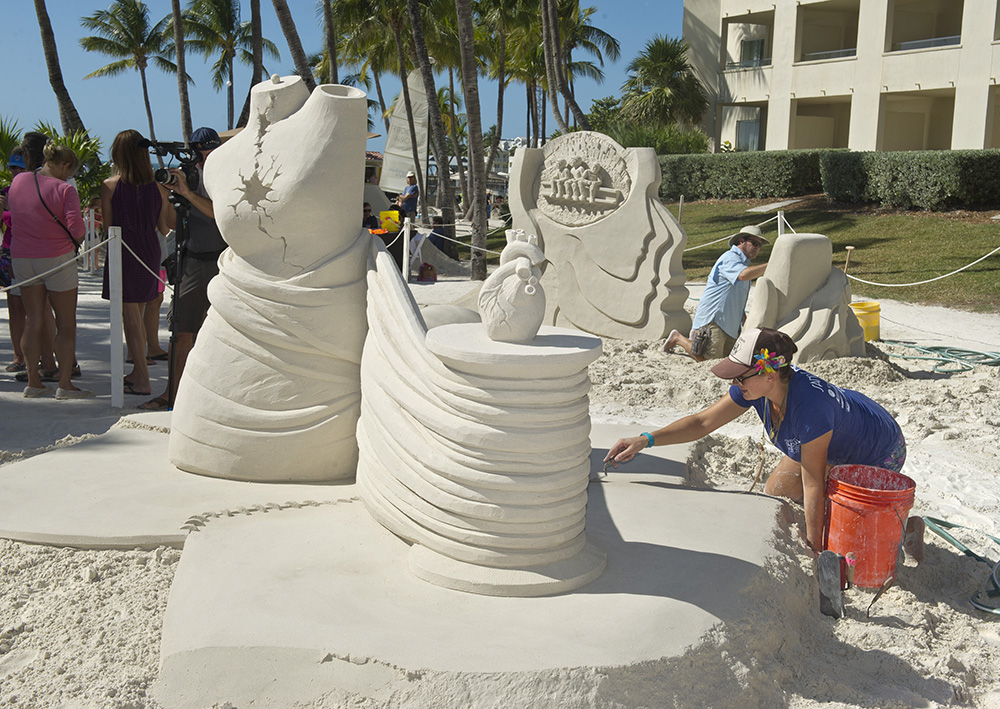For Morgan Rudluff, Key West’s third annual International Sand Art Competition offered a personal catharsis. For Rusty Croft and Abe Waterman, it provided an opportunity for thought-provoking social commentary. And for spectators watching six artists carve sand at the beachside challenge, it illustrated the triumph of passionate creativity over an impermanent medium.

Singapore artist Joo Heng Tan wields hand tools with gentle, precise strokes to embellish his abstract sand sculpture, titled “The Drop.” (All photos by Rob O’Neal, Florida Keys News Bureau)
In fact, sand is so impermanent that few artists are interested in pouring days of thought and intense, sometimes uncomfortable effort into sculpting it into abstract designs or figures. And (as any kid who’s ever built a sandcastle knows) it can also be uncooperative, unpredictable and collapse without warning.
Yet for the sculptors who participated in the competition on Key West’s Casa Marina Resort beach, those qualities are all part of their chosen medium’s attraction.
“The impermanence of sand sculpture is like a metaphor for life,” said competitor Rusty Croft, who’s been carving sand professionally for 19 years. “I like to think of it as a note of music or a fine glass of wine or a sunny beautiful day — enjoy it, and it’s gone.”
As well as Californians Rusty and Morgan and Canadian sculptor Abe, the international field included Joo Heng Tan from Singapore, Key Wester Chris Guinto, and Guy-Olivier Deveau from Canada’s Quebec City. At the beginning of the Thanksgiving weekend challenge, each received more than 15,000 pounds of sand to work with. According to contest rules, they could use only the sand, water, and a few simple hand tools to create their sculptures.
For three and a half days, as fascinated spectators watched, the pieces took shape under a sunny subtropical sky. The six artists crawled around their individual patches of sand, concentrating intently on their emerging creations, wielding trowels and knives and brushes with gentle yet precise strokes. And when the work was done, the impermanent sculptures communicated lasting messages.

Abe Waterman’s “One Love” was an artistic plea for unity. Each competition entrant received more than 15,000 pounds of sand to create a sculpture, using just water and hand tools.
Morgan Rudluff spent her time crafting a female torso, shattered at heart level, and connected to an external heart by a smooth unrolling sweep of fabric. Inspired by a painful personal experience, it was titled “Unravel. Break. Mend.”
“It’s the catharsis for my heartbreak,” Morgan explained. “Making this piece is the heart of the mending for me.”
Abe Waterman also used imagery of the heart, carving a sculpture that was a powerful plea for unity. Titled “One Love,” the piece consisted of five figures of varied ethnicities, standing solidly shoulder to shoulder and back to back, surrounding a shared heart.
“A lot of these artists are just world-class phenomenal, and they’ve taken it from your everyday sand castle to ephemeral art — real, full-on modern art that could be in a gallery anywhere,” said Rusty.
His own piece, striking and clean-lined, presented a tongue-in-cheek commentary on contemporary life. Called “Out to Lunch,” it contrasted early 20th-century American steel workers’ simple lunch breaks with the current-day cell phone and Internet obsession that keeps people from living in the moment.

Rusty Croft crafts a supersized cell phone to complete his artwork — a commentary on the contemporary immersion in mobile devices.
“It’s kind of a play on words — literal out to lunch, and figurative ‘out to lunch’ — how a lot of us seem to be preoccupied these days,” Rusty advised.
Also created on the Casa Marina beach were Guy-Olivier’s mythology-influenced “Succubi,” Joo Heng Tan’s intricately etched cone-like towers, and Chris’s large-scale curving seashell that (unfortunately) collapsed before its completion.
Couples and families strolled among the sculptures, marveling at the work, casting their votes for “People’s Choice” awards, and seemingly reluctant to leave the beachside “gallery” for other pursuits.
Rusty Croft didn’t find that surprising. He enjoys sand as a medium for his sculpture, he explained, because of the near-universal connection it creates with viewers.
“Everybody has played in sand at some point in their life, so to see us take it to the next level and spend days on a piece really captures their imagination,” he said. “It has that connectability, that tangible aspect — it’s in us all as an artistic medium.”

